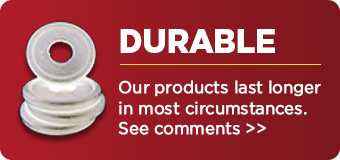Rubber Moulding
Introduction
This article contains all the information you need to know about rubber moulding.
You will learn more about topics such as:
- What is Rubber Moulding?
- Types of Rubber Moulding
- How Rubber Moulding is Made
- Advantages of Rubber Moulding
- And much more…
Chapter One – What is Rubber Moulding?
Rubber moulding is the process of converting uncured rubber or elastomer into a finished product by transferring, compressing, or injecting the raw rubber material into a metal mould cavity. Applying pressure and heat initiates a chemical reaction, such as curing or vulcanization, which causes the polymer chains in the rubber to cross-link and solidify.
All rubber manufacturers utilize heat and pressure in their production processes. The most common rubber molding methods are injection molding, compression molding, and transfer molding. As products continue to evolve, rubber mold producers are constantly adapting to meet the increasing demand for grommets, gaskets, o-rings, and seals.
Chapter Two – Uses for Rubber Moulding
Both synthetic and natural rubber can be moulded into complex forms and shapes, significantly expanding its versatility. Its flexibility and durability allow engineers to design effective seals and cushioning components. Rubber’s stability makes it ideal for cushioning machinery, helping to reduce impact and vibrations.
Although natural rubber remains widely used, manufacturers have developed synthetic alternatives that offer comparable strength with enhanced durability and longevity. Materials such as neoprene, silicone, ethylene propylene diene monomer (EPDM), and various elastomers provide similar properties to natural rubber but with increased flexibility and endurance.
Rubber Bumpers
Rubber bumpers are available in various shapes and sizes, including recessed, mushroom, stem, grommet, and tack bumpers, to suit different manufacturing needs. These bumpers help reduce vibration and movement in equipment, protecting rigid parts from damage caused by impacts and vibrations. They are used to safeguard furniture, work surfaces, circuit boards, displays, and packaging.
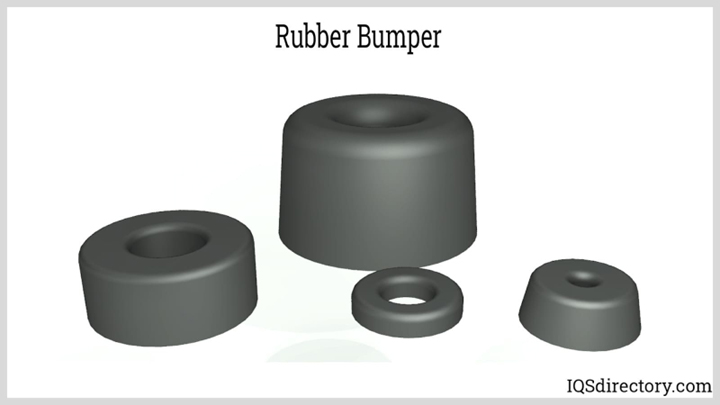
It is important to note that polymers like EPDM can also undergo chain scission and cross-linking. Nevertheless, because cross-linking reactions are more dominant, there is a higher chance of the polymer hardening over time.
Rubber Bushings
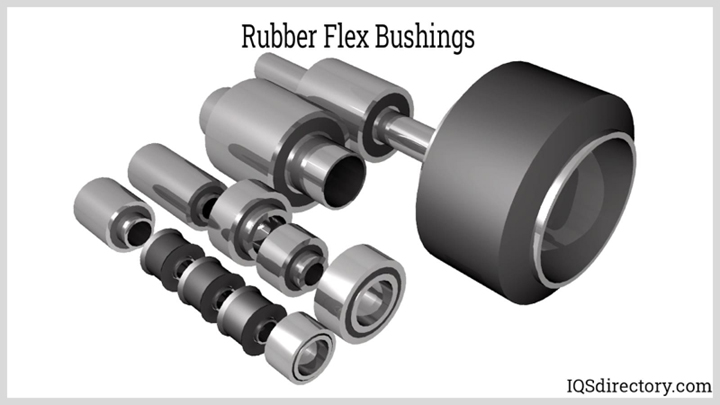
Rubber Grommets
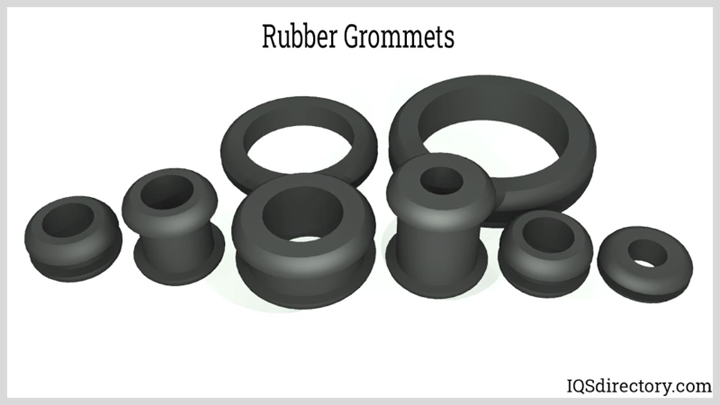
Rubber Isolators
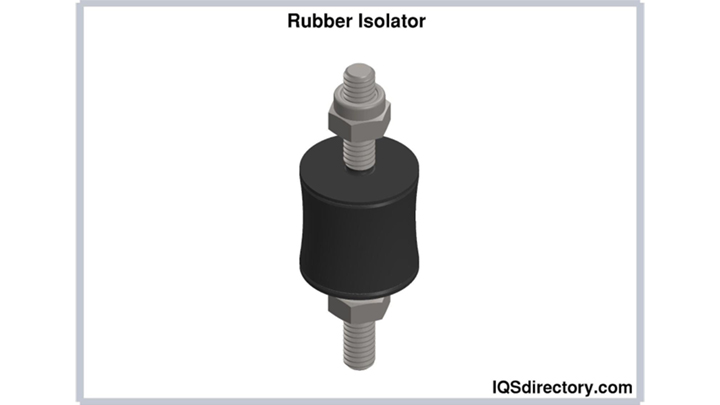
Rubber Mounts
Cylindrical mounts are commonly used as supports for conveying lines and transfer equipment, while other types serve as supports for tabletop equipment like computers and printers. The straightforward design of rubber mounts facilitates easy installation and maintenance. The metal threads are engineered for quick attachment to the supported device, ensuring both stability and protection.
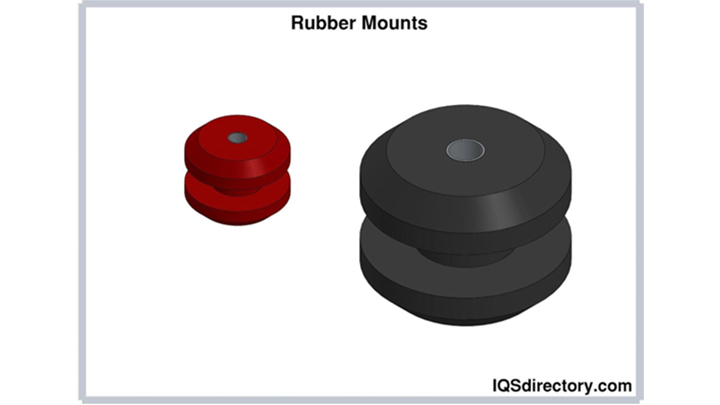
Rubber Seals
Rubber seals are used to close gaps, insulate spaces from water or liquids, and protect surfaces. Because sealing is crucial across a wide range of equipment and processes, rubber seals are highly customizable and can be adapted for various applications. They are particularly important in processes involving pressurized liquids or gases. Rubber seals can come in forms such as gels, films, putties, or strips and can adhere to materials like glass, ceramics, concrete, paper, and other porous surfaces.
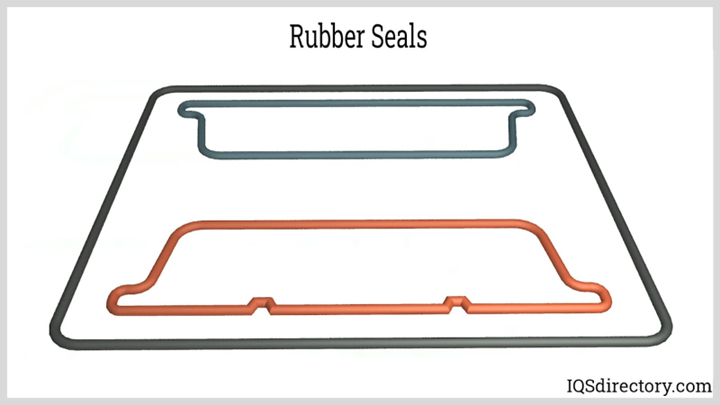
Rubber Suction Cups
There are two main types of suction cups: flat and bellows. Flat rubber suction cups are designed for use with smooth, flat surfaces. In contrast, bellows suction cups are suited for handling irregular surfaces, such as vehicle panels, tubes, and various molded products. Bellows suction cups offer greater adaptability and versatility compared to flat suction cups.
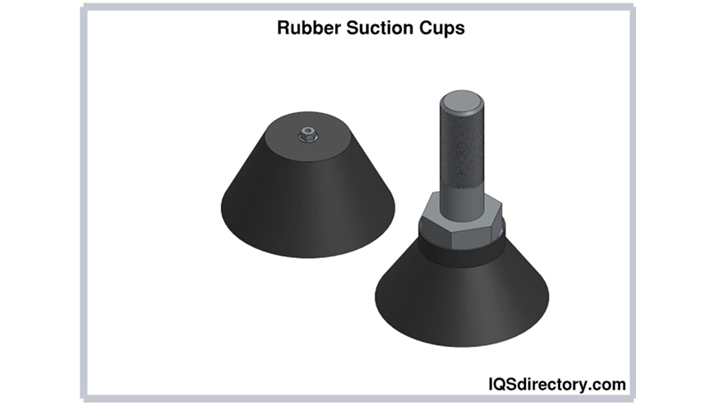
Rubber Washers
When used for pipe connections, rubber washers typically prevent leaks and secure the joint or connection. Their ability to form a tight seal makes them suitable for various conditions, ensuring reliable and leak-proof performance.
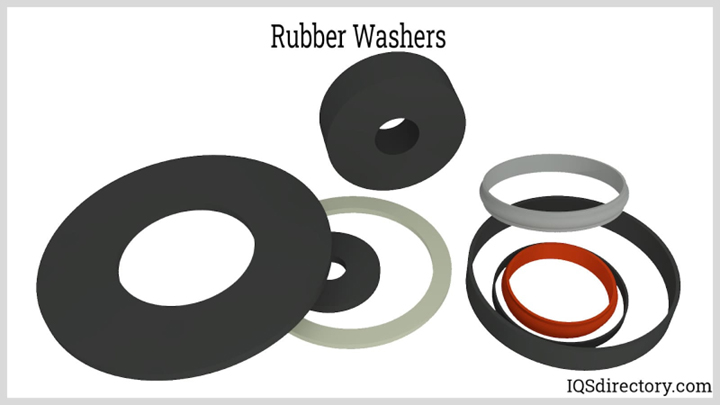
Rubber O-Rings
When selecting an O-ring, it is crucial to consider the maximum pressure it will need to withstand. O-rings are designed to compress naturally between two surfaces to prevent air and fluid leaks. If subjected to pressures beyond their design specifications, O-rings are likely to fail, compromising the seal and potentially causing leaks.
In all applications, O-rings with a larger cross-sectional diameter offer better resistance to compression sets and reduced volume swell in liquids. Conversely, smaller cross-section O-rings provide superior physical properties, resist explosive decompression, and occupy less space. For components with tight tolerances, rigidity, and smooth or ground surfaces, smaller cross-sectional O-rings can be used effectively, even under high pressure.

Chapter Three – How Rubber Mouldings are Made
Designing Rubber Moulds
Rubber can be moulded into complex shapes and designs. During the design phase, specific configurations are incorporated into the rubber geometry to make production more cost-effective. Engineers must carefully consider the parting line and its location, ensuring it has a minimal draft angle. The mould design is crucial, as it lays the groundwork for part development and can significantly impact the success or failure of the final product’s production.
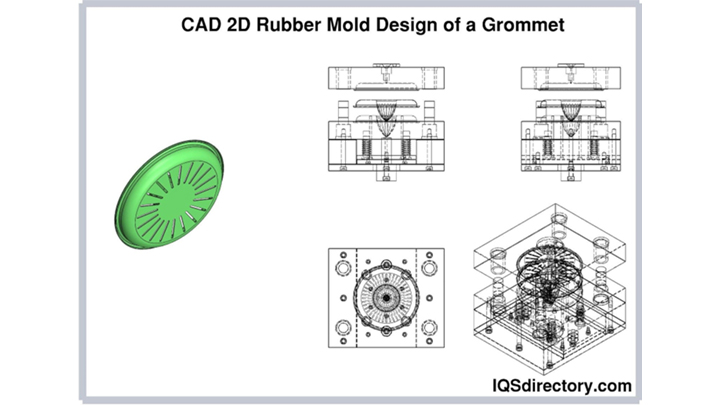
Producing the Mould
Once the mould has been cast and manufactured, it undergoes rigorous testing to ensure dimensional accuracy and compliance with the original design specifications. This testing phase involves measuring and inspecting the mould to confirm that it meets all required tolerances and performance criteria. Any discrepancies or defects identified during this phase are addressed through adjustments or refinements to ensure that the mould will produce high-quality, precise rubber components during production.
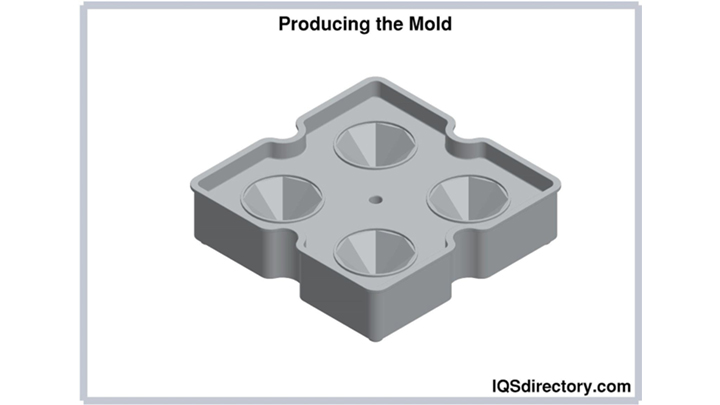
Vulcanization in Rubber Moulding
Compression Moulding

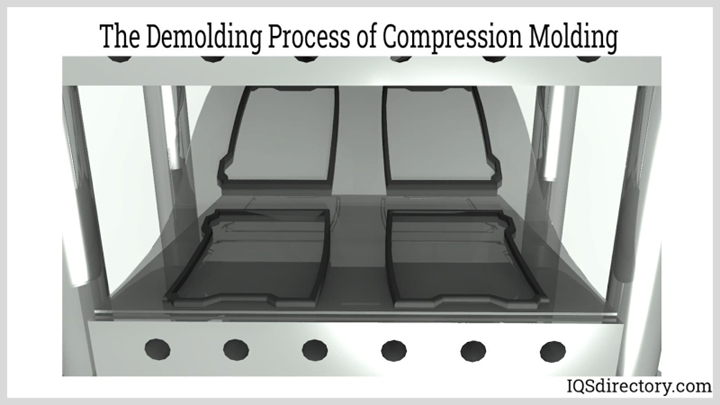
Transfer Moulding
Transfer moulding is a highly efficient process with short tool loading times. While parts produced may not have tight tolerances, the process supports high production runs. Once curing is complete, the mould is separated, and the parts are released.
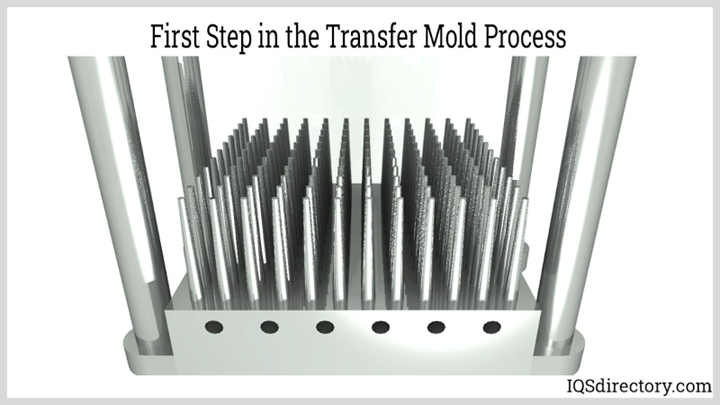
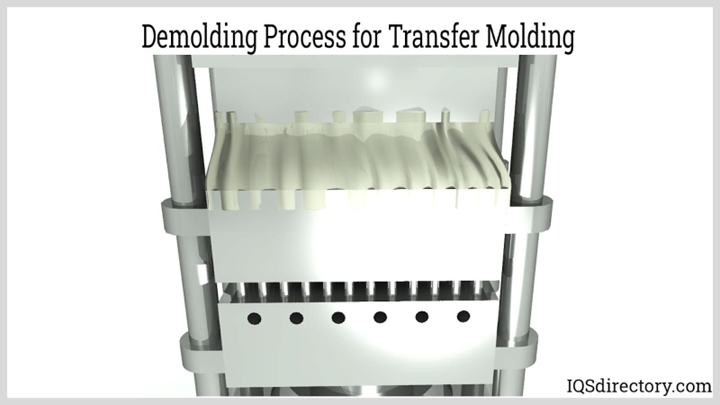
Rubber to Metal (RTM) Moulding
Rubber-to-metal molding (RTM) is a process used to bond vulcanized rubber to metal, providing isolation from noise and vibrations. Each RTM method is designed and engineered to meet the requirements of specific applications, offering features such as high fatigue strength, resistance to aging and temperature, and recyclability.
In RTM moulding, vulcanized rubber is used to create an elastomer that bonds with the metal substrate during the vulcanization process. The metal is first primed and coated with a polymer solution mixed with other ingredients. The rubber and additive blend, combined with sulfur as a catalyst, is then molded with the metal substrate under heat and pressure.
During vulcanization, the metal interacts with the primer, topcoat, and rubber to form a layer adjacent to the metal substrate, creating a strong bond approximately 10 to 20 microns (µ) thick. The polymer molecules in the rubber cross-link, which prevents them from moving independently, thereby enabling the rubber to withstand stress and retain its original shape.
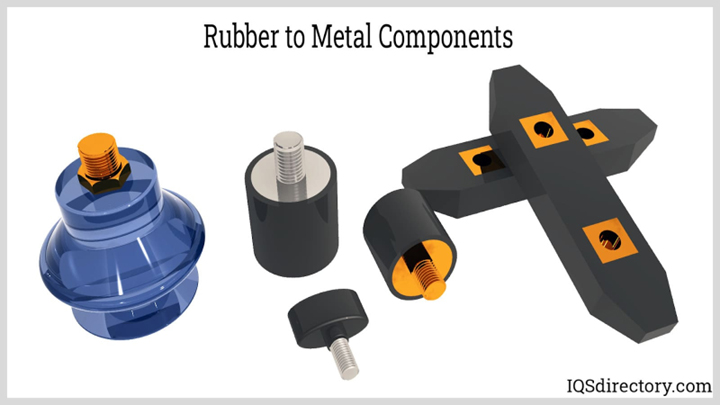
Chapter Four – Types of Rubber Used for Rubber Moulding
Natural Rubber
Nitrile or Buna-N (NBR)
Hydrogenated Nitrile Butadiene (HNBR)
Ethylene Propylene Diene Monomer (EPDM)
EPDM’s exceptional resistance to heat, weathering, ozone, and UV radiation makes it a key material in the automotive sector, where it is used for weather seals, gaskets, and radiator hoses. In construction, EPDM roofing membranes offer durable, waterproof solutions. It is also widely used in electrical insulation, providing safety and longevity for electrical systems. Additionally, EPDM’s flexibility and durability make it valuable in the marine and HVAC industries, where it is employed for gaskets and seals that must withstand harsh environmental conditions.
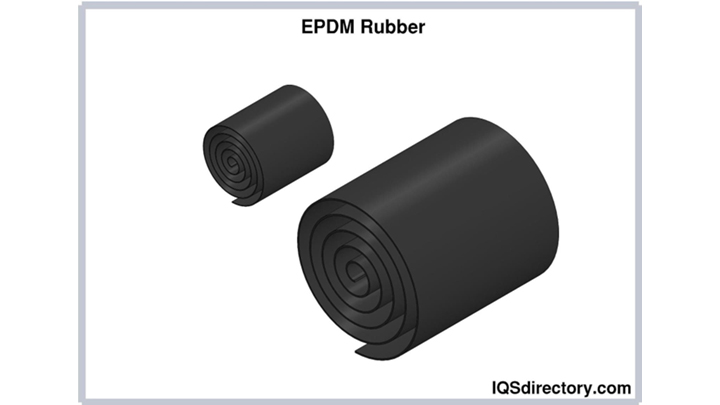
Neoprene™
The automotive sector relies on neoprene for gaskets, seals, and hoses due to its resistance to oils and extreme temperatures. In the sporting goods industry, neoprene’s flexibility, durability, and insulating properties make it ideal for wetsuits, diving gear, and protective equipment. The medical field uses neoprene for orthopedic supports and braces because of its comfort and hypoallergenic qualities. Additionally, neoprene’s resistance to chemicals and weathering makes it a valuable material in construction, particularly for waterproofing applications.
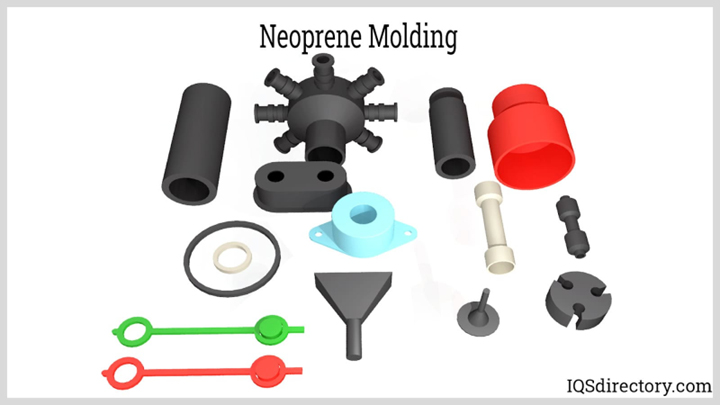
Silicone
In healthcare, medical-grade silicone is crucial for producing implants, prosthetics, and medical tubing due to its biocompatibility. The aerospace and aviation industries use silicone-based coatings to protect aircraft from harsh environmental conditions. In construction, silicone sealants and adhesives are valued for weatherproofing, bonding, and their resistance to extreme temperature variations.
Fluorosilicone (FVMQ)
Fluorosilicone is a type of silicone that includes trifluoropropyl groups, which enhance its resistance to chemicals, non-polar solvents, fuels, oils, acids, and alkalis. Like silicone, it remains highly adaptable across a wide range of temperatures. Its durability and resistance to petroleum products make it especially valuable in the aerospace industry.
Fluorocarbon (FKM)
FKM, or fluororubber, is made from VITON and is classified based on its chemical composition, fluorine content, or method of cross-linking. The classification ranges from one to five, with each type featuring a distinct copolymer. FKMs can be cross-linked using diamine, dihydroxy, or peroxide materials. FKM’s properties, including its resistance to chemicals and extremely high temperatures, make it ideal for molding hoses, O-rings, gaskets, and fuel lines.
Styrene Butadiene (SBR)
SBR (Styrene-Butadiene Rubber) is primarily made from butadiene with a small percentage of styrene, copolymerized using the emulsion process. It exhibits outstanding resistance to abrasion, cracking, and aging. These favorable properties make SBR ideal for rubber molding applications such as diaphragms, seals, and gaskets.
Butyl or Isobutylene Isoprene (IIR)
IIR (Butyl Rubber) is produced by copolymerizing isobutylene with isoprene, compounds derived from natural gas or crude oil. The materials are combined at temperatures as low as -150 °F (-100 °C). IIR is impermeable to gases, making it ideal for manufacturing seals for high-pressure and vacuum applications. Additionally, it possesses sound-dampening qualities, making it suitable for use as a bumper in equipment.

Polarity of Rubber
Chapter Five – Advantages of Rubber Molding
Compression
Compression moulding involves placing a preformed piece of rubber into a heated mould. When the mold is closed, the preformed rubber is compressed against the mould’s sides. The products are formed under high pressure and temperature, which triggers the curing process.
Advantages of Compression Moulding
- Cost-efficient
- Less expensive tooling
- Increased cavity count
- Perfect for larger pieces needing extended curing time
- Accepts all forms of elastomers
- Eliminates the need for runners, sprues, or gates
- Simplified process
- Little to no waste
Transfer Moulding
Transfer molding utilizes a closed mold system and involves rubber pellets or preformed rubber. These materials are placed in a pot situated between the top plate of the mold and the plunger. The plunger heats the pellets in the pot and forces the material down the sprue into the mold cavities. The plunger stays in place until the material conforms to the mold shape and cures.
Advantages of Transfer Moulding
- Economical process
- Cost-effective tooling
- Shorter cycle times
- Highly precise parts
- Tight dimensional tolerances
- Long curing time for larger products
- Accepts all types of elastomers
- Multiple parts produced during each cycle
- Greater design flexibility allowing for sharp edges
- Reduced flash
- Simple process with pot, plunger, and mold
Chapter Six – Industries Served by Rubber Moulding
Rubber-moulded products have a virtually limitless range of applications, making them valuable across various industries, including automotive, aerospace, and spacecraft manufacturing. The proven durability of rubber-molded components has established them as essential elements in numerous industrial processes.
Aerospace
In the aerospace industry, rubber components must be exceptionally reliable and meet stringent performance standards not typically required in other sectors. These parts need to be highly durable, resistant to weathering, and capable of withstanding sudden temperature fluctuations. For the safety of passengers and aircraft, gaskets and seals must also be resistant to oils, gases, and fire.
This manufacturing technique is used to produce a variety of critical components, including sealing gaskets, vibration dampeners, and custom seals for aircraft windows and doors. Rubber moulding offers a durable and flexible solution that ensures safety and performance under the demanding conditions of flight. Its capability to create complex, customized shapes with tight tolerances makes it essential for meeting the highest efficiency and safety standards in aerospace engineering.
Automotive
The automotive industry relies on rubber parts across various sections of vehicles, from brakes and clutch seals to battery gaskets. Rubber’s noise suppression capabilities make it ideal for use in consoles and other interior components. Its ability to withstand extreme temperatures, chemicals, and mechanical stress makes it well-suited for applications such as engine mounts and tire treads, enhancing the durability, safety, and overall performance of vehicles.
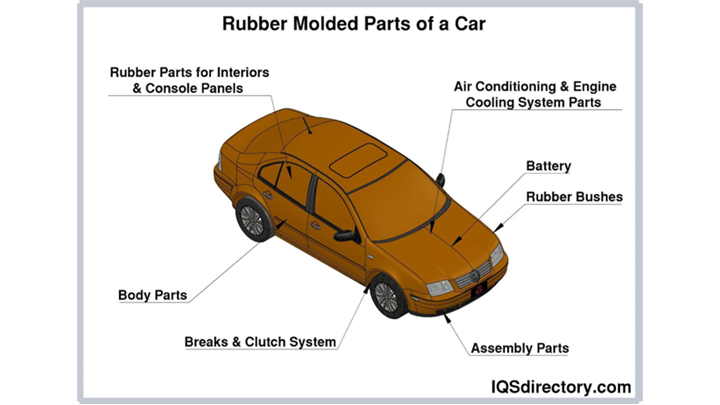
The flexibility of rubber moulding enables the production of intricate and specialized components, which enhances the quality and efficiency of printing equipment. Rubber’s resilience and resistance to wear and tear make it an ideal choice for durable and long-lasting printing solutions.
Home Appliances
Rubber moulding also improves safety by offering insulation against electrical currents and shock hazards. Its non-slip properties are ideal for enhancing grip on handles and buttons, thus improving user control and ergonomics. Additionally, rubber moulding helps dampen vibrations and reduce noise levels, contributing to a quieter and more pleasant home environment.
Electrical
In the electrical industry, rubber-moulded products are crucial for safety and protection. These products include outlet covers, shock protection components, chemical-resistant parts, solutions for reducing electromagnetic interference, and seals to guard against dust and moisture. As with other industries, these components must be durable, resilient, and user-friendly.
The primary concern for the electrical industry is adhering to standards and regulations designed to protect workers and ensure safety.
Agriculture
Rubber moulding produces gaskets and seals that provide essential protection and safety for handling the various chemicals used in agricultural production.
Medicine
Another critical factor for medical instruments is the need to meet stringent standards for patient treatment. Manufacturers must strictly adhere to regulatory requirements and restrictions to ensure public safety and protection.
Food and Beverage
The FDA specifies acceptable rubber compounds for use in parts and components within the food and beverage industries. The primary concerns are that materials must be non-toxic and non-carcinogenic to ensure safety for consumers.
Chemical
Rubber moulding’s resistance to corrosive chemicals and extreme temperatures makes it an ideal choice for gaskets, seals, and custom components used in chemical processing equipment. It ensures a secure, leak-free environment, preventing hazardous substance leaks and enhancing safety. The flexibility of rubber also allows for the creation of intricate shapes and sizes, meeting the diverse needs of the chemical sector.
Conclusion
- Rubber moulding is a process of transforming uncured rubber or an elastomer into a usable product by transferring, compressing, or injecting raw rubber material into a metal mold cavity.
- The most common methods for rubber moulding are compression, and transfer.
- Rubber‘s flexibility and durability offer engineers different ways to design seals and cushioning components.
- The purpose of the moulding process, aside from shaping parts, is to subject the rubber material to chemical processes that toughen or harden the polymer chains of the raw rubber.
- Rubber moulding is an essential part of the rubber production industry since components, parts, configurations, and designs can be produced to exactly fit the needs of an application.

